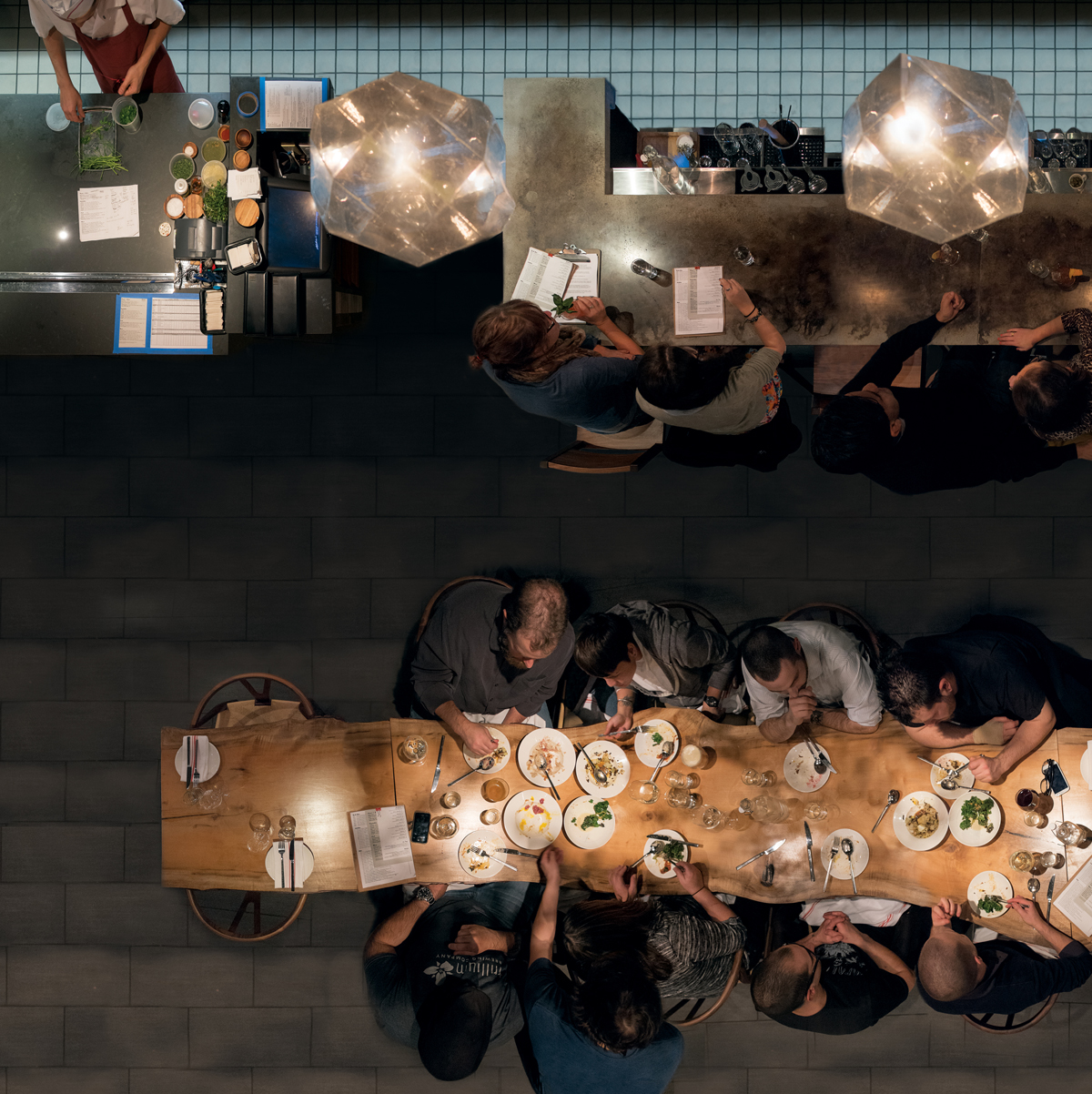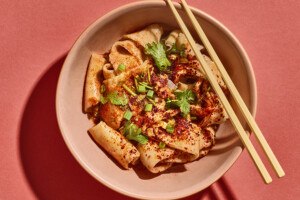Restaurant Review: Ribelle in Brookline

Photograph by Justin Hamel
When chef Tim Maslow revamped his father’s Watertown diner, Strip-T’s, a couple of years ago, he brought a new kind of fusion food to Boston that was unhackneyed, original without straining for novelty, and fascinating—and I started sending everyone I knew there. But directing visitors to a Watertown restaurant called Strip-T’s took some explanation: The seats were fairly rustic, the waits long, the noise off-putting. Now Maslow is going for grownups at Ribelle, a restaurant and bar in Brookline’s Washington Square with an Italian point of view. And given the speed of his evolution toward real artistry—and the stream of New York visitors who have started to nose around his new place—we might want to take active steps to make sure Maslow stays put.
Unlike at Strip-T’s, the setting at Ribelle requires little apology. There’s a long, elegant bar running along one side of the big, shoebox-shaped space. The look is minimalist but soothing, and luxurious in its way, thanks to modern chandeliers with clear rock crystals, dove-gray walls, and muted beige grass cloth mounted behind banquettes. Beautiful planed-tree-trunk tabletops snake down the long spine of the room for flexible group seating. Noise is still an issue, but not the deal-breaker it can be at Strip-T’s. The bar serves up the requisite craft cocktails, less food-friendly than complex and worth pondering on their own, like the “Son of Man” ($13), calvados with Cynar and Montenegro. It was the first time I’d had amaros mixed with a fruit brandy: good, potent, and better after dinner.
And the food? Unconventional, as you might suspect given the restaurant’s name, a rare Italian word that translates to “rebel.” Once again, as at Strip-T’s—where smoked miso and sriracha and Thai chilies are tucked into burgers and fries—Maslow’s tenure in David Chang’s Momofuku empire comes through in stick-to-your-ribs, meaty, flavor-over-everything dishes. What’s changed is the point of reference: from wings and fried chicken at Strip-T’s to familiar-sounding Italian-American staples like rigatoni in marinara that turn out to be anything but familiar.
What hasn’t changed is Maslow’s need to push the frontiers of flavor. That rigatoni with marinara? The house-extruded pasta tasted nutty from toasted spelt flour and was surprisingly tender for a spelt-based noodle; the marinara sauce it was served with was smoked, but rather than smoky registered as the sun-baked, brick-red tomato flavor you find only in Sicily ($15 as a first course, $25 as a main). You almost resent the end of the dish. How’d he get so good at pasta, which barely appears at Strip-T’s? Ambition and curiosity. For months while working at Momofuku, Maslow apprenticed making pasta in the mornings at Del Posto, where executive chef Mark Ladner runs what could be the most rigorously Italian kitchen in New York City.
Maslow seems never content with just one layer of flavor. Every bite has overtones, undertones, complements. He works crosswise, not stopping at—or bothering with—just balancing acid with sweet, say, or salt with sugar. A purée of cascabel, guajillo, and ancho chilies, for instance, found its way into an otherwise-sweet pumpkin sauce for mafalde pasta ($13 as a first course, $19 as a main). Cranberries and more chilies added to the usual sweetness of eggplant-tomato caponata ($7) served with house-made semolina bread, and gave it depth along with the powerful olive flavor of the first-press Greek oil Maslow says he goes through by the gallon.
In all of the dishes, sweet, starch, fat, heat, and smoke came in and out of view in marvelously unpredictable rhythm. The mayo for a grilled Greek sardine ($14) was based on duck fat; sweet, starchy, earthy salsify was the foundation of the plate. The redeye gravy on roasted Brussels sprouts with sour cream and potato ($13) contained fermented hot sauce and apple butter. It wasn’t immediately apparent—I just thought, Wow, what a savory, meaty redeye gravy this is (the surprise depth usually comes from coffee, the defining ingredient).
What makes Maslow’s food so consistently interesting—though, over the course of my visits, not consistently executed or successful in all pairings—is that crosswise imagination. Other chefs have superior technique, or rely upon a kind of macho, offal-driven shock value that seems to be taking hold as if by bad-boy mandate. Maslow doesn’t shy from offal himself (tuna blood lines, usually discarded, were instead cured and hidden in a mushroom dish, for example). But no ingredient seemed to be added just for shock value or novelty. This is food that matches Thomas Keller’s famous maxim that he doesn’t want to be bored after three bites. Even when a dish didn’t quite work, you still wanted to taste more, until you figured out what the shadings were.
Some of the dishes were subtle and intellectually engaging, yes—but not at the cost of lusciousness. Example: duck-liver mousse ($13), an item you might think would be an entrée because it’s listed within the last of four menu categories, “meat.” (Everything could be considered a small plate or a main course, and the ever-changing dishes varied greatly by portion.) The mousse was certainly substantial enough to be a main—and might even have been the best dish on the menu—but it was more of a traditional appetizer, served with terrific, olive-oily, hand-rolled grissini, thin and pointy as knitting needles. The mousse was made with offal you won’t notice—liver, of course, plus gizzard and heart that had been cured for several days, roasted, then puréed with butter, cream, and sherry. The accompanying sauce gribiche, sliced hard-boiled eggs with capers, was creamy and gave texture, and the chamomile honey with herb vinegar thickened with pectin on top was one of the better sweetness heighteners to liver or foie gras I’ve had in quite a while. It was silken heaven.
Similarly unctuous and deep-flavored were pieces of whole fresh porcini mushrooms slowly cooked in olive oil with thyme, citrus peel, and other aromatics ($16). It reminded me of how long it has been since a local chef put whole porcini on a menu, and how meaty they can be—or maybe Maslow just cooks them better. In this case, the accompaniments didn’t add much to the mushrooms: prunes poached in merlot vinegar and honey, and those seasoned and cured yellowfin-tuna blood lines, which, although an inspired addition, barely registered. But it didn’t matter, with the depth Maslow coaxed from those mushrooms.
The Kurobuta pork chop ($27), one of the only clear examples of an entrée, was the sweetest, moistest pork I’ve had since the last time I was at Bondir, so good that it hardly needed the maitake-mushroom ragu that would usually be there as an umami-booster—though slices of vinegary red onion on top were a pleasant counterpoint.
Some menu items were simply odd: pig’s-head torchon ($15), a puck of pressed gelatinous pig parts you’ll like if you have a taste for the texture of chicken feet and trotters; dull cod ($26) with an oily, murky peanut romesco that plastered over the already fugitive flavor of the fish. Others were outright misfires. To wit: Agnolotti ($17), despite showcasing more of Maslow’s noteworthy pasta technique, suffered from a filling—short rib and smoked bone marrow—that was far too smoky and weirdly, almost inedibly, sweet.
But then Maslow will return to simplicity and turn out a dish like blackback flounder in an old-fashioned white-wine-and-garlic piccata sauce with greens and roasted radishes. The most expensive dish at $30, every part was carefully thought out and prepared expertly, yet so simple and clear that it seemed effortless. Another winner: a huge slice of that semolina bread with poached egg set into a hole and fontina cheese melted over it, sautéed on the plancha and layered with sweet-hot fresh shishito peppers ($12). The truffle salt on top mercifully added only a hint of earth (no truffle oil, thankfully), and made this the perfect late-night snack or hangover cure—just where Maslow said he found it, when he would get off Momofuku shifts at 2 a.m.
Desserts weren’t up to the rest of the menu: I confess to eating every last drip of olive-oil ice cream ($7) coated in a thin and prettily Dairy Queen–like chocolate sauce, but other places do that as well or better. Have some caponata or truffled egg toast instead. Service was as concerned and kindly as at Strip-T’s, which has set the new model for hipster cool that can be warm in its welcome and attitude-free. But servers also had a tendency to vanish, not know the answers to questions they never came back to answer, and drop orders. That’s a sign of the quick popularity.
Persevere. One Monday night, a table for four was occupied by David Chang with his parents and brother. A woman at our table went up to Chang to tell him what an admirer of his she is, and asked him about the chef. “He’s amazing,” Chang told her. “He knows everything.” I get that loyalty—which is why Maslow left New York in the first place. “To tell you the truth,” he told me when I interviewed him over the phone about some of the dishes, “I came up here not to make a name for myself but to do something great with my dad,” who’s his active business partner in the new restaurant and with whom Maslow lived until recently. He did what he came to do. Now let’s see how we can keep him here.
MENU HIGHLIGHTS
Spelt rigatoni • $15/$25
Brussels sprouts • $13
Duck-liver mousse • $13
Grilled Greek sardine • $14
Kurobuta pork chop • $27
Porcini mushrooms • $16
Ribelle, 1665 Beacon St., Brookline, 617-232-2322.
Critic Corby Kummer—an editor at the Atlantic and author of The Pleasures of Slow Food—has been reviewing Greater Boston’s top restaurants in our pages since 1997.


